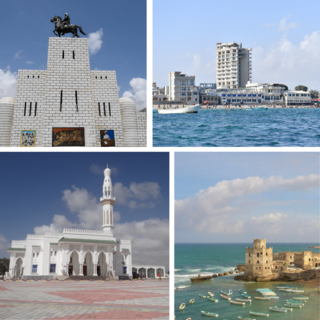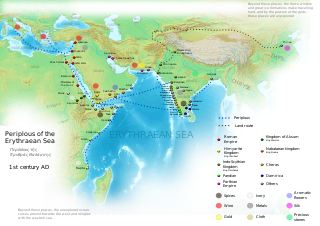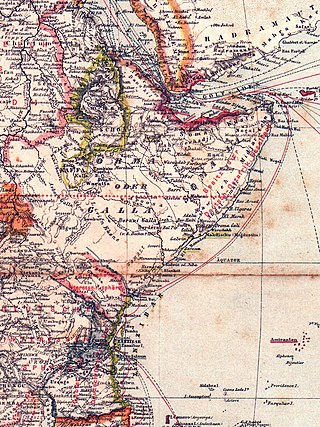
Galguduud is an administrative region (gobol) of Galmudug state in central Somalia. Its administrative capital is Dusmareb. The largest town in the region is El Buur, which lies at the centre of the region.

Bakool is a region (gobol) in southwestern Somalia.

Middle Shabelle is an administrative region (gobol) in southern Somalia.

Lahoh, is a spongy, flat pancake-like bread. It is a type of flatbread eaten regularly in Somalia, Djibouti, Kenya, Ethiopia, Yemen and Saudi Arabia. Yemenite Jewish immigrants popularized the dish in Israel. It is called canjeero/canjeelo in southern Somalia and also called laxoox/lahoh in Somaliland, Djibouti, Yemen and Saudi Arabia, respectively.

The Abgaal are a Somali sub-clan of the Hawiye and the even larger Samaale clan. This prominent Somali clan, despite being one of the youngest in Somalia, is one of the most significant in the nation's history and has given rise to many notable figures, including three presidents, including the current one as well as the founding father of the Somali military. Their stronghold is the capital city of Somalia, Mogadishu, where they are known to be the earliest inhabitants and they currently constitute the majority of the population there.

The African Union Mission in Somalia (AMISOM) was a Multinational force formed by the African Union. The operation deployed to Somalia soon after the Islamic Courts Union was deposed by troops from Ethiopia during a large scale invasion in late 2006. The missions primary objective was to maintain the regime change between the ICU and the newly installed Transitional Federal Government, implement a national security plan and train the TFG security forces. As part of its duties, AMISOM later supported the Federal Government of Somalia in its war against Al-Shabaab. AMISOM was the most deadly peacekeeping operation in the post-war era.

The Ajuran Sultanate, natively referred to as Ajuuraan, and often simply Ajuran, was a medieval Muslim Empire in the Horn of Africa. Founded by Somali Sultans it ruled over large parts of the Horn of Africa during the Middle Ages via control over water. Its rise to prominence began during the 13th and 14th century. By the 15th century, the Ajuran were Africa's only 'Hydraulic empire'. Through a strong centralized administration and an aggressive military stance towards invaders, the Ajuran Empire successfully resisted Oromo invasions from the west and fought against Portuguese incursions from the east.

The Sultanate of Hobyo, also known as the Sultanate of Obbia, was a 19th-century Somali Sultanate in present-day northeastern and central Somalia and eastern Ethiopia. It was established in 1878 by Yusuf Ali Kenadid.
The Hawadle are a Somali clan who trace descent to Meyle, one of the sons of Irir Samaale. The Hawadle, as well as many other Somali clans stem from Samaale.

The Banaadiri people are a people group in Somalia. Banaadiris largely inhabit Somalia's southern coastline.
Warsheikh is an administration center and coastal town of Warsheikh district. Warsheikh is located in the southeastern Middle Shabelle region of Hirshabelle State of Somalia. On the south, Warsheikh is bordered by the Banadir region, and on the north Adale District.
Sheekh Ahmed Gabyow was a famous Somali poet and warrior mullah from the Abgaal Hawiye clan. Gabyow lived in the coastal areas north of Mogadishu in the first few decades of the Italian occupation. He was well known for the masafo reciting and producing several dozen as a genre of Somali poetry that is usually composed by religious men.
Mogadishu currency was an old coinage system minted by the medieval Sultanate of Mogadishu.

Sarapion was an ancient port city located in the Horn of Africa.

Hudun District is a historical district in the Sool region of SSC-Khaatumo Its capital lies at Hudun. The border between Hudun District and Las Anod District goes through the town of Buur Anod, also called Buur Caanood, a town that lies in between the towns of Dib Shabeel to the north, and Daryaha (Daryaha) to the south. This was the site of the largest battle between Dervish and colonial forces in 1904.
Adale, also known as Cadaley, is a coastal town in the southern Middle Shabelle region of Somalia.

The Majeerteen Sultanate, or Majerteen Kingdom also known as Majeerteenia and/or Migiurtinia, was a Somali kingdom centered in the Horn of Africa. Ruled by Boqor Osman Mahamuud during its golden age, the sultanate controlled the areas which are now called Puntland. The earliest mention of the kingdom is the 16th century. The polity had all of the organs of an integrated modern state and maintained a robust trading network. It also entered into treaties with foreign powers and exerted strong centralized authority on the domestic front.

This is a 2014 timeline of events in the Somali Civil War (2009–present).

German colonial efforts on the Somali coast were pursued from 1885 to 1890. Representatives of the German East Africa Company signed friendship and protection treaties with local rulers in the coastal cities of Somalia in 1885 and 1886 with the aim of acquiring areas north of Wituland. In 1888 and 1890, respectively, the project, which overlapped with British and Italian claims, was abandoned.
This page is based on this
Wikipedia article Text is available under the
CC BY-SA 4.0 license; additional terms may apply.
Images, videos and audio are available under their respective licenses.












